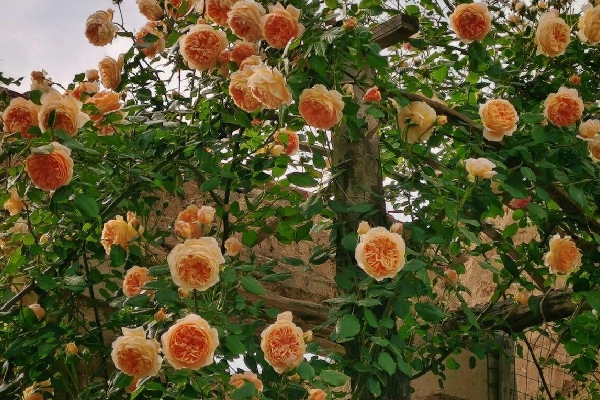All Posts
How to Grow Climbing Roses?
Climbing roses produce long canes that are perfect for trailing on pillars, fences, gazebos, and arbors. They bear large single or clustered flowers along the stems. Climbers can be encouraged to bloom more profusely by training their canes horizontally. Securing them loosely to the supporting structure will encourage the young shoots to climb.
Climbing roses often burst into a prolific display of flowers in spring and then sporadically bloom throughout the rest of the growing season. Their flowering pattern depends on the variety planted. Deadheading the flowers regularly can promote continuous blooming. If you decide to prune the plant for the first time before winter, it can increase the number of blooms later. These perennial plants are cold-hardy in zones 4-11.
Where to Plant Climbing Roses
Climbing roses need support structures such as plant obelisk trellises, pergolas, garden arbors, or fences, and they require enough space to spread out and get the airflow necessary for maintaining health. Unlike true vines, they don’t climb on their own and can’t support themselves, so gardeners often need to tie the roses to the plant support at multiple points.
Plant climbing roses in a location that receives ample sunlight for most of the day. They prefer well-draining, fertile soil. If needed, improve the soil with compost or other organic materials before planting.
How and When to Grow Climbing Roses
The best way to start planting climbing roses is as bare-root plants. Plant them at the end of winter or early spring when the soil is not frozen or waterlogged from winter snow. This gives the roots time to establish before the hot summer. Bare-root plants adapt easily to new soil as they are not transplanted from other growing media.
Don’t wait too long to begin training the roses onto supports; the stems become woody and challenging to handle. In most cases, simple ties with natural jute twine or other soft materials can suffice. If you plan to train roses to grow on a wall or solid surface, install a trellis or support system a few inches away from the wall. Without support, roses cannot climb hard, smooth surfaces. Leave some space behind the plant to promote good air circulation.
If the planting area has poor drainage, amend the soil with compost or well-rotted organic matter. Before planting, soak the roots of bare-root roses in water for a few hours. Dig a hole approximately 18 inches by 18 inches and form a mound at the bottom of the hole. Place the rose, allowing the roots to spread loosely over the mound. The plant should sit at soil level. Backfill the hole with soil and gently press down with your hands, then water the plant.

Caring for Climbing Rose
Climbing roses require the same care as regular rose bushes.
Light
Roses can tolerate some shade, but they perform best when receiving four to six hours of full sunlight daily, resulting in larger and fuller blooms.
Soil and Water
Fertile, well-draining soil is ideal for roses. If your soil is lacking, enhance it with fertilizer or compost. They prefer moist soil with a neutral to alkaline pH. Soil should be well-draining. Each rose plant needs about 2 gallons of water per week, but be careful not to overwater, as this can lead to root rot.
Temperature and Humidity
The ideal temperature for climbing roses is between 50°F and 80°F. If the temperature exceeds 80 degrees Fahrenheit, ensure your roses get some afternoon shade to protect them from excessive heat. Similarly, if the temperature drops below 32°F, cover the plants but avoid covering them too early in the season. Wait until the first frost.
Fertilization
For the first planting of climbing roses, add compost to the soil. Once the plants are established, use a balanced fertilizer every two to three weeks as per the manufacturer’s instructions. Stop fertilizing about eight weeks before the first expected frost to limit potential damage to new growth due to cold temperatures.
Pruning
After one or two years, when your climbing roses are established, you can start pruning them regularly. Typically, you only need to prune climbing roses once a year, after the first main bloom. This is a good time to deal with any diseased or damaged canes and prune to improve airflow or guide future growth. Avoid pruning roses in the fall, as pruning stimulates new growth.
Container Planting and Repotting Climbing Roses
Container planting is effective for climbing roses, just like for rose bushes. Pots need to be large, at least seven to 10 gallons, as climbing roses grow vigorously and spread upward. If the roses are small varieties, providing support by inserting small trellises into the pot during planting can be sufficient. However, for standard-sized roses, positioning them close to a trellis or fence is a better option for support to avoid the pot becoming top-heavy.
Use a mixture of peat moss, potting soil, and mulch, and fill the pot halfway. When planting roses, keep the bud union (the junction between the stem and the root system) about 2 inches below the soil surface. Water regularly or set up a drip irrigation system to keep the soil consistently moist.
Supporting and Training for Climbing Roses
Climbing roses are usually trained to suitable supports such as garden arches, obelisk trellis or expanding trellis. As they can easily grow to heights between 7 and 13 ft., they will always require some form of support. As mentioned, the classic solution is to train them onto garden arches and also flower arbours. Other options include larger, solid garden obelisks, sturdy free-standing trellises, pergolas, rose tunnels and wrought iron gazebos. And of course, fences, wall trellises and iron railings are also suitable.

